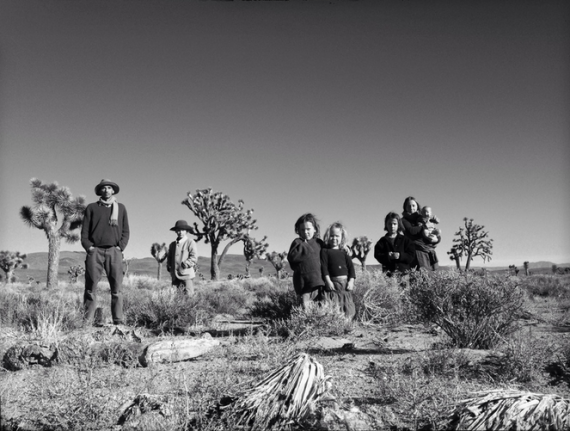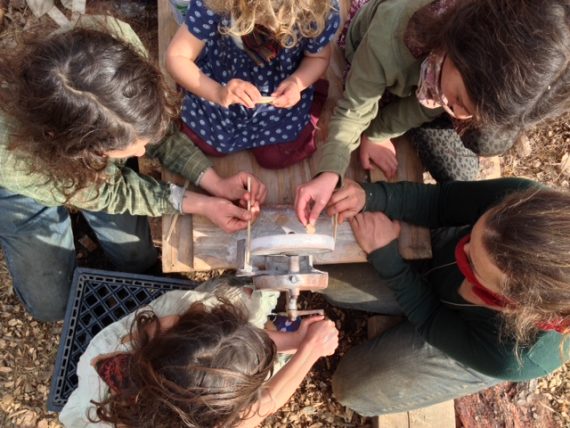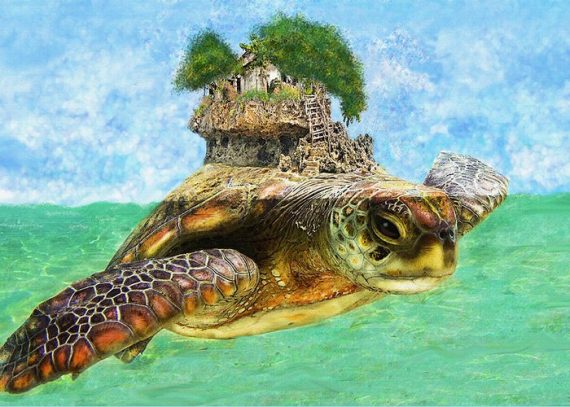
6: ON BELONGING
In this sixth episode, On Belonging, we meet three people who have thought a lot about what ‘home’ means to them and how that relates defines their relationship to a place. All were present at Standing Rock. Dark Mountain contributor Andrew Blanchflower and his partner Kayla Blanchflower of Rogue Dwellings, and Yvette Neshi Lokotz of Star Nations.
Podcast transcript of episode 6: ON BELONGING
Welcome to Nordic By Nature, a podcast on ecology today inspired by the Norwegian Philosopher Arne Naess, who coined the term Deep Ecology.
As Naess once wrote, there seems to be no place for PLACE anymore. The things, we need appear like magic into our lives. For that convenience we often have to sacrifice connection and community. We become isolated from each other as we become more dependent on faceless corporations to provide the things we need, rather than people who produce them. Our ecological selves are being separated from the very idea of home. But somehow, the loss of place is felt, on a deeper level, and the longing for home persists.
According to Naess and deep ecology, we need to articulate what it means to belong to a place.
For example,
Number 1. As humans, we are locally and globally connected at all times. Our everyday life patterns and culture interweave with every other living thing. We need to understand this experience if we are to create profound relationships of stewardship for our own lives and the lives of future generations.
Number 2. We must not confuse a place with our own house. We do not own a place. Other humans and non-humans have the right to be part of the ecology of a place. It is important for us to share our sense of place with others, for that a place to thrive. It does not threaten our own identity or way of life to invite others to share the spaces where we feel we belong.
Number 3. Natural experiences are not commodities to be consumed. A place is a living entity, a collection of interconnected ecosystems. A place has a value independent of the services it provides humans. But humans can be an integral and natural part of an ecosystem.
Number 4. There is Wilderness and there is Countryside. One sees Nature as separate to humankind and the other sees humankind as a Keeper of Nature. Both concepts are human constructs.
Number 5. We need to regain a sense of scale. Places and their ecosystems are being degraded by massive amounts of waste. Microscopic damage is also occurring depleting the soil and our nutrition. We must also conserve the invisible equilibrium on which all life relies.
In this episode ON BELONGING, you will hear from three people who have thought a lot about what ‘home’ means to them and what defines our relationship to a place.
First you will hear the words of Andrew and Kayla Blanchflower, tipi dwellers and makers whose way of the life can be an inspiration to all of us to live lighter. Andrew and Kayla met and fell in love in Oregon in the States, and decided to raise their family with a closer contact to the earth and Mother Nature.
You will then hear the voice of Yvette Neshi Lokotz teacher of hand drumming and making, practitioner of the Medicine Wheel or Sacred Hoop healing, and tribal member of the Potawatomi Nation.
Please listen to this podcast with your headphones.
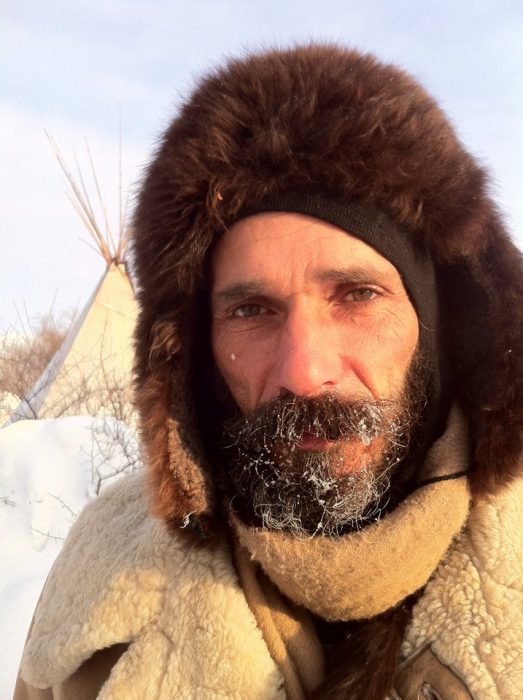
Andrew Blanchflower, founder of Rogue Dwellings.
Andrew’s Story
My name’s Andrew. I’ve lived in tipis since the early ‘90s. The story goes back to those days in Hulme. We would go up to Saddleworth Moors and graze on mushrooms in the autumn. I think that was my first taste of the system that was bigger than any political system that there is the system that is…I could just call it Mother Earth or Gaia right now….
SOUND: Walking through woodland
We’d come back to Hulme like this low rise six story social housing disaster, which was actually great for squats and young, single people and ….I think I’ve forgotten that time of my life my early growing up until my late teens that there was such a longing and such a missing, like, I remember that when I see people in town these days just with that confusion or that… that kind of “there’s something bigger than this, I know that there’s something bigger than this or just something… that has to be more.”
I remember having these conversations the Shenyen who was then named Martin and it would be like: “What was the most amazing life that you could dream of, that you could imagine+” For Shenyen, it was being an ordained monk in India or Tibet. For me it was living in a tipi.
SOUND: Yorkshire-moors.wav
And then it was like “Okay well can we just, do you want to just try moving towards that and see what happens?” And so that’s what happened, and then I met people that live in a tipi community in Wales of all places and my people that live in tipi he’s in Wales all year round to me was a revelation that people could still actually do that.
And I met some of those people at various festivals, at Glastonbury Festival and various healing gatherings, and they were just making a cup of tea around the fire, and I was just perceiving these people like these amazing epic characters that knew how to just boil kettle in a few minutes.
SOUND: BLESSED BE SONG.m4a
SOUND: 2. ANDREW PENNYWHISTLE.wav
INTRO: KAYLA’S STORY
SOUND: 3. BACKGROUND BIRDS KAYLA.wav
I love the way we met. I think it’s, it’s so romantic. He was playing the penny whistle. There was one evening he was playing in this little town called Ashland in Oregon and at night he was playing his whistle on the street. And I was out for a walk. I was actually quite heartbroken that night. And I was going on a walk with a friend, sort of crying and sharing my, my broken heart. And then we parted ways this friend and I, and I heard this whistle in the distance. It just felt so healing and soothing to me and so I decided I would close my eyes and walk to where that whistle was coming from.
And now here we are. However, many years this is later. This is like almost 20 years later and we have five children.
On Tipi Life
ANDREW Basically we live in tipis because we can be on the ground around the fire. Like it’s a way of manifest in our elements directly. I can get wood and water, find the spring or a creek or something. There’s like two basics taken care of as far as elements.
KAYLA At the moment everyone’s busy in the shop. All the kids are in there making things; we’re making shoes for the trip, and making backpacks, a travelling lodge and a bag for the travelling lodge, and Ayla is making some gifts. She wants to bring these baby carriers to give to some kids that she knows over there. Yeah. everyone’s really busy using the sewing machines right now and making things for the journey and that’s a lot of fun.
SOUND: 4. WHITE THROATED SPARROW.m4a
KAYLA So we have five children. All of our children were born to living in the tipi.
That’s sort of one of the things that I kind of captivated me about Andy was that he, he lived in a tipi and he had come from a tipi community in Wales, and he knew how to make them, and how, how to live in them in a way that wasn’t like roughing it or camping but quite luxuriously.
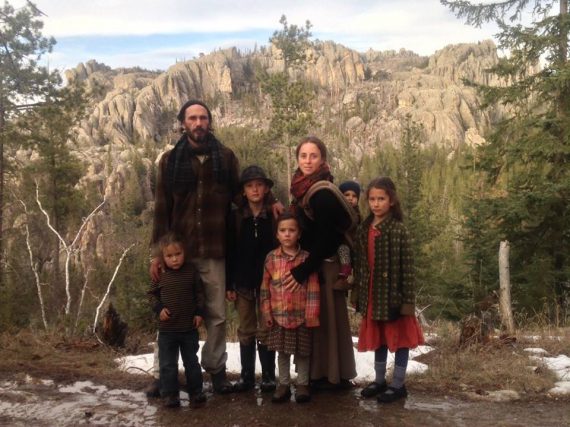
The Blanchflower Family
And so all of our children were born to the tipi. Not all of them were born in it. Some were born outside of the tipi or in water, or our firstborn was born in a birth centre. It was a beautiful birth and it was that birth that then set up the rest for us to be pretty strong about just having him and I be there for the births.
So, we had a midwife for our first child and she was a wonderful woman. She’s dear in my heart. I have sought counsel with her throughout all the rest of our children, but not as a regular midwife and she did not attend any more births.
I’m grateful for her and it really helped me get in touch with the wisdom in my bones of just how to how to birth with a lot of love with whatever family was around.
SOUND: 6. AMBIENT LODGE 1.wav & 7. AMBIENT LODGE WATER.wav
On Tipi Village, from Wales to Oregon
KAYLA It was when we were pregnant with our second child that we wanted to just be somewhere wild where we could feel really comfortable and at home and so we decided to just go to those mountains in the distance, and we set up our lodge, and I don’t know a little while after we set it up maybe some days or so. someone came down and it turned out they were the title holders.
But they loved the Tipi. We made them tea which is what we’ll often do when surprise visitors come. And you know let the fire do its magic on them like it does. They came down and they had tea and they welcomed us and said that they you know they had access to thousands of acres. They opened it up to us. I mean that the short version.
And that’s where the valley the tipi Valley model where Andy came from in Wales had such a strong influence in this little place in Oregon which we ended up calling tipi village.
It’s amazing that those stories, those people, those events, in Wales they’re all of those how far they travelled and how they’re like seeds that floated over and just grew in this other place, and I guess stories do that. They kind of travel like that.
People would come and visit and find out if they wanted to stay for a while or not. It was a pretty organic process because you know, if if people were up for it, fetching wood and water and cooking on a fire, and living with the elements, and dealing with mould and rodents, and you know, rain dripping in and all of these things that have to be dealt with– then they would, you know, they’d make themselves a tipi and rise to it and love it —and
other people would find you know quickly or not so quickly that it wasn’t for them, and so there was no need for any, you know, egos to get involved to say you can be here. You can’t be here. The earth did the sorting out. I guess, maybe.
SOUND: 2b Rattle.wav
ANDREW Tipi Valley in Wales they always had that big lodge that was always open, and it brings so much perspective. If we want new stories new narratives, we can look back to stories that 5000 years old what’s so common in a lot of those folk tales, is the answer to the problem comes from the periphery. It doesn’t come from where we’re looking at the problem. Like it comes a spirit of the lake or an old woman in the roots of the tree or…. But we have to be open to that we have to be at that point. Maybe it’s not going to be until we’re at that point of desperation that we will be open to that and hear it.
SOUND: 8. DINNER BLESSING.wav
On what is home?
Fireplace and FIRE CRACKLING.m4a

Sewing in the workshop tent
KAYLA [00:10:58] What does home mean? These are thinking about these things are really they’re meaningful to me, and we talk about them often in our home. It’s been quite a thread for us because of I guess we kind of considered ourselves as ‘displaced’ which is interesting to say because Andy isn’t from the west of Turtle Island but we made our family there, all the kids were born there this whole village from out of the ground and blossomed there, other children in the community were born there.
For many years we all moved together seasonally. There was a summer grounds and winter grounds and so we’re very connected with a place there.
We moved within a range, a valley, and a mountain range and so we had high elevation camp and we had a low elevation camp.
We often hear that the only place where that’s normal is where you’re at like the Nordic regions is like that that kind of stuff is more widely accepted and known in here. It is a little bit. I mean sometimes we’re in places where we might be a bit more of the freak show. We don’t find so many but enough that we aren’t alone really. Right now, all winter we’ve been living on this beautiful ridge and with three other families.
I mean a community doesn’t need to be a huge amount of people, there’s enough people here where we can bounce off each other and there’s enough, you know, diversity be amongst the different skills between the grown-ups that the kids can like, you know, they go to what’s inspiring for them for input and there’s other children here and they have this wide open wild space to just be in and learn about together.
SOUND: 11. CRACKING FIRE & ROWAN.m4a
On Stories
KAYLA Because I think there is some great power to us knowing the stories of a landscape and feeling how our stories are woven into those stories and then we know our place because we know the land so I feel like home. Place is relevant in talking about home, but I don’t think it’s exclusive to place and I think it could be at least here in the United States, there’s that consciousness of its like its ‘settler colonialism’ that really claims a place and says this is mine.
ANDREW Stories really intimate and woven in with place, like they come from a place and they emerge out of the ground. As far as a new narrative is becoming apparent that a monolithic… a single narrative isn’t really the way forward. It seems like in order to find unity we’re having to kind of decentralise. Someone a few years ago on a radio show was talking about that the only thing that unites us is our uniqueness. Like the thing that unites us does our uniqueness. We’re all different. So the ability to adapt. We’re forgetting how to adapt.
People are forgetting how to write down on paper, through the seduction of convenience, people forget how to feel a bit uncomfortable, and just rise to the occasion. I don’t know what there is to do other than just try and be resilient and adapt.
ANDREW That brings it back to that relationship with place being something more dimensional than mere economics. It is just one single level or dimension of how a holistic relationship to ‘place’ can be.

Rogue Dwelling Tipi in snow
KAYLA I think at that time I might have been very much one to say that home in place were more closely related but then as Tipi village, I mean the story as tragic, and it’s beautiful and it was you know, the land titles shifted hands and that’s a long story.
It was enough for us that push was enough, and we got a school bus real quick and made a quick conversion and got on the road and for the first year I would say we travelled around just traumatized and gutted like we had lost everything that, that meant something to us like the birthplace of our children, and we had such a vision woven in with that place, of a future of a way forward that we were so dedicated to and believed so firmly in.
Tending the land, tending wild plants, returning seasonally, watching it grow, living lightly with a place, as a people, as a community. So then that’s when I think the journey of being separated from place but still maintaining home, began for me personally.
SOUND: NeshiDrumming_6/4/19_2.mp3 (DIEGO Arrangement)
On Standing Rock
KAYLA: And then we kind of heard that call to go to Standing Rock. Well not kind of. It came through really strong. That’s another story. I mean it was quite an incredible direction for us to head in, after having gone through the seven years of tipi village, and being able to be in a bus, with a workshop that made tipis, and we can just pull up to Standing Rock and make shelter and have our home with us. And I think that’s where maybe the journey began to shift for me in realising that home is much bigger than a place because we got there, and it felt like we met our people. I met our people.
And that our people live all around the world, like people were there from so many places, but there was such this common thread that united us. And we kept saying in so many ways it was like we had gone home.
It had such a profound impact on our lives. We were there for a year. It was the land of the paradox for me just the richest place I’ve been.
The spiritual richness was so potent that fire was burning so strong and that’s what kept us there for that long and the poverty and pain that’s there is equally as strong. It’s just the poorest and richest place. And I guess I am speaking beyond our time in camp at Standing Rock because we stayed on further with relatives that we met who live on the various reservations in the Dakotas and lived with them after the camps were closed down in February. We continued on, pitched our lodge with some other people who live between the Pine Ridge Reservation and the Rosebud reservation
On Nature and healing
ANDREW This thing that they pejoratively called the environment as if it’s an issue as if it’s something that needs to be taken care of as if it isn’t the whole of everything. All of life runs through this about out of proportion, I think.
KAYLA We’re all very present. We don’t have anywhere else to be except right at home and with each other. We’d like to say that sometimes it’s kind of like we have seven pairs of eyes were like this one body with all these eyes and all these noses and all these ears just kind of moving through space and time together and and so it feels like we’re that much more aware if we’re in it together taking care of each other paying attention to each other’s bodies. But we heat water on the fire. We have a washtub. That’s how we have baths. The healing journey requires getting sick together.
We’re blessed to have each other to have the family. I send a bit of that good feeling out to those who aren’t as fortunate to have a family container to hold them through their challenging times.
I feel humbled and blessed that we do have that with each other and we have all the time we’re so rich with time so there’s just no hurry or there’s no loss of job money. Getting ill, it has information in there of how to be live even better, how to be more activated in ourselves, maybe.
Our bodies are maps.
On being open
KAYLA With the way we move with in the bus and where we’ve been travelling across the country. It’s sort of been a requirement that we be very open. I mean I guess we could do it in a closed way but I just that’s just not the way we do it. We move really slowly and in a very open way always receiving whatever guests we meet. It’s it’s so curious to me the way a journey can unfold when we go with such open minds and heart.
Especially with technology these days we could really plan our route and plan where we stay and close our reality down so much with all this planning and being so destination bound, and then I think we miss out so much, and so, by being so open, we’re always in contact with so many different kinds of people, which I think grows in our kids a kind of adaptability and some resiliency. and a way to navigate different cultural contexts.
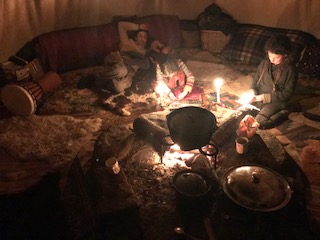
Cosy at home
ANDREW Well the way we’ve done Chai is to serve it straight out of the bus because we have a 1988 Chevy Bluebird school bus like classic American school bus, and that’s what we travel, we carry our whole trip in that which is a tipi and a 28 foot seven-sided tensile tent shop.
So we might just be pulled over in a rest area or in a town and we’ll put a sign up saying “Now serving organic Chai” on the sign is to say. Donations welcome and then we thought it has a poor aesthetic, so we just even scrubbed that off, and people still managed to make donations, and sometimes… sometimes someone wouldn’t leave anything, sometimes… most people leave a couple three dollars to occasionally someone’s left one hundred dollars or bunches of kale or someone’s brought us some venison or Buffalo or whatever.
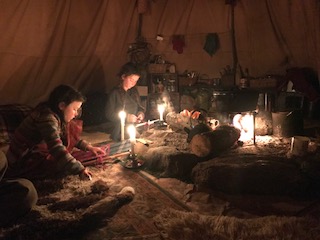
Hearth living
We pull up in the town and the person who’s got TB poles on the roof is painted brown and it’s got water protective signs on the side and people are curious and often there’s a person in a uniform who’s bold enough to come and talk to us and you know we’ll charm them but. we have to invite everyone in for a cup of tea because if we don’t, if we’re not open, then we’re dangerous and we’re suspicious because we are so different.
And it is curious that there is a longing. People come in and they just smell it. And I don’t know what we smell like anymore, like mostly we just smell like wood smoke, I think, you know we’ll be cooking in there and there was a smell of chai and, time and time again, there’s just that longing for trust.
I think it’s it’s not like there’s no fear there anymore it’s more like a willingness to engage with that fear and maybe that’s what we have to do in order to stop plundering our ecology our environment is just give over and relax and know that there is enough abundance in the world.
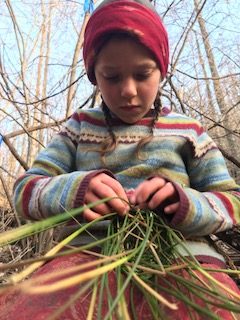
Playing and learning skills
SOUND: 10. FIRE COOKING.m4a
Everyday life is our home
KAYLA There’s these threads we have that we bring through wherever we go; the tipi and the fire and all the dailies that are required to keep that functioning and I think those are like it’s kind of the main spokes of the basket. That kind of give it some structure, and some kind of that’s their identity maybe? Maybe it’s maybe it’s like this is what we we are as a family is is what we do. We have our bus and our lodge, and we move seasonally and we don’t claim any one spot but we like to meet lots of people, and love places as we go if it’s planting trees or building labyrinths or developing springs, at different places, or transplanting things, or gathering plant medicines or praying, building sweat lodges.
There’s so there’s so many ways that we engage with the places that we go and love them where we go and then and then we are moving on. But I have to say there is some heartache and sadness about…it’s almost like we have to keep moving because of the way the system is set up.
I’m not entirely like anti…staying in one spot and I don’t. I’m not against that. It’s just not viable unless we do it in this very entitled way. This land ownership thing but tending to a place and loving a place and getting to know the stories of a place and weaving into it, I think that’s profound.I think this is crucial really for a sense of well-being, and for our knowing our own individual place and all of creation.
Even when we look at hunter and gatherer cultures, I don’t think they that people have ever just wandered around that there’s been a purpose. If it’s going for. A certain food that is ready in a certain place with the certain time of year.
When the salmon run or when the maple syrup is flowing, the wild rice is ready.
ANDREW This time last year we were in New Hampshire and we were tapping maple trees where we made 15 gallons of maple syrup and we still have some leftover. It’s that way of just diversifying. From my experience of travelling with indigenous peoples, and indigenous cultures it’s like there’s a resilience woven into those kinds of cultures.
Looking back to the dictionary definition of what Indigenous means, basically emergent from place. If I can emerge from a place like the elements that make my body, that way is to be alive. If I can honour that as much as possible as part of a… like everything else in creation. I am a strand in a multi-dimensional shimmering tapestry of life that is all my relation, which means all my relationships.
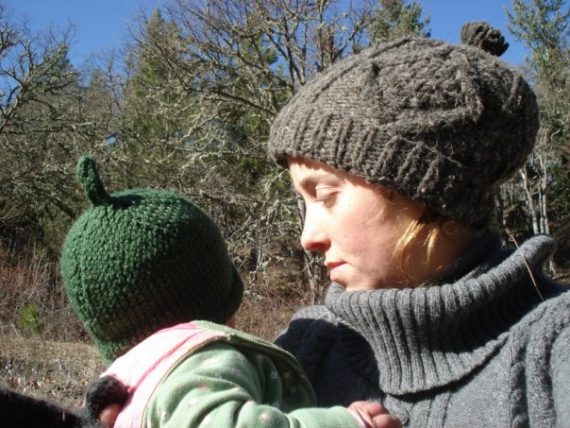
Kayla
So, it’s like we have all these relationships not just the physical well I can see and hear and feel and touch around me. But things that make up what is me they the things within me and without me. How does that shimmer in the way that it’s supposed to in the way that all the rest of creation has the potential to do — if I can perceive it like that?
SOUND: REFRAIN OF 2. ANDREW PENNYWHISTLE.wav
KAYLA There’s intention and purpose. It’s not kind of a bumbling about so working with what we have, it’s been beautiful, there’s people here who take care of this place. They said come and be here for the winter. And so we have, we’ve arrived. We’ve been here as fully as we can. This is art we’ve loved this place. And it’s been amazing. Arriving in the fall when it was all going to sleep. And now being here in the spring in this completely new landscape that we don’t know a lot of these plants and trees and they’re all waking up and coming alive and surprising us at every turn. We had no idea. We were surrounded by trees that were going to give off so much colour in the spring. It’s been beautiful to get to know a new place.
It’s been quite an epic and beautiful journey. A lot of it just feeling like it’s a journey of coming more whole, and a lot of weaving.
I think we weave so beautifully together, Andy and I.
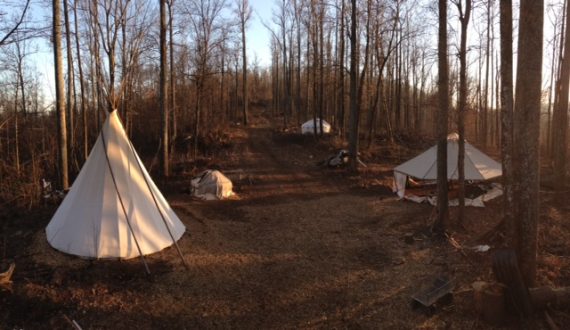
Living light means living in harmony with nature, with the least negative impact
END
SOUND BRIDGE TO NESHI LOKOTZ VOICE & NESHI 24m. DRUM MEDITATION.mp3
NESHI:
In your imagination
Imagine going to a place of nature
It’s so beautiful there
This is your special place
A place that you know so well
That you may have been many times
Could be in yur back yard
It could be out in a park
By a lake the ocean and the mountains
Your special place….
—————————————————————————-
NESHI INTRO
Bosho, that’s hello in Potawatomi. My name is Yvette Neshi Lokotz, and I am from Turtle Island, the United States, and I am a Native American woman.
I would like to introduce myself in the old way. You always want to know who your people are, see if you’re related.
SOUND: NeshiDrumming_6/4/19_2.mp3
(Introduces in Potawatomi language)
(Nesh nabe nos wen, Bneshikwe. Nshe dodem tthigwe. Dwagen, Tomah Wiscconsin. Nshe mesho, Skama-ben. My Gaga, Ho Chunk, Spreading Wing. Nshe nos, Kabance-ben. Nshe no ye nan, SheweKwe.
My name is Bneshi-kwe, which means bird woman, , my clan is Thunder. I live in Tomah, Wisconsin. My grandfather, Misho, Shkama-ben. My grandfather’s name was Shkama-ben that he has walked on; He’s passed away. And his native name, his Indian name, meant new chief. My grandmother who is Ho Chunk, I don’t know how to pronounce her Ho Chunk name but it meant ‘Spreading Wing.’
And my father, Kabance-ben means that he passed away, the ben part, but Kabance means to Walk On Earth. And it’s really about the imprint of the moccasin in the soil on Grandmother Earth.
And my mother who is still living. She-We-Kwe means ‘Leading Elk’. And so that is how we would normally introduce ourselves so they have an idea of how to address you. It’s all about who is connected to you. It’s much more personal.
SOUND: Rattle.wav
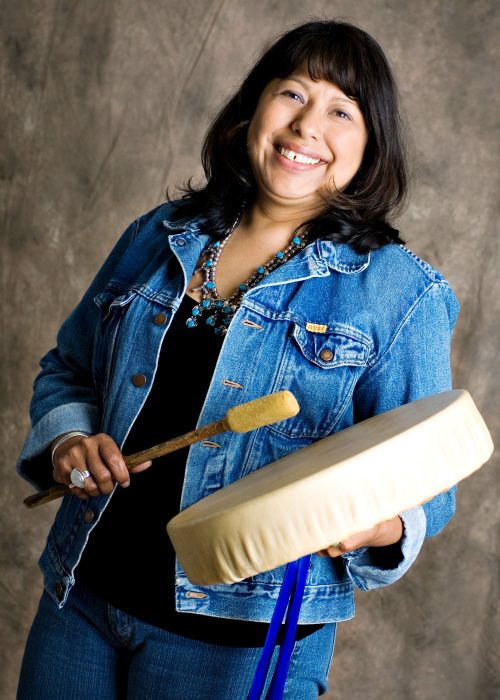
Neshi Lokotz Sacred Hoop Drum Maker and CEO of Star Nations, and Star Nations Radio
NESHI INTRO CONTINUED
I’m an enrolled member tribal member of the Potawatomi Nation, the Prairie Band. There are nine bands of the Potawatomi Nation. When we were forced onto reservations is when we kind of got split up that way. And that’s on my mother’s side. Her father, my grandfather. Skama-ben, he was he was the Potawatomi.
We follow the patriarchal line, and this has more to do with the colonization. We’re enrolled underneath my grandfather’s who was an original lottee number when he went to the reservation.
My grandmother on my mother’s side is Ho Chunk. We might classify her as an activist. She was she was one of those people who would be a part of changing the norm. And so she was a very strong woman. My grandmother on my mother’s side.
Ho Chunk has been in Wisconsin for hundreds and hundreds of years. The Potawatomi started out on the East Coast and migrated west.
On my dad’s side, he was a Mexican Indian. Yaqui is his nation. Where he is from would have been around the southern border between Texas and northern Mexico. The Yaqui nation actually is on both sides of a border now. (laughter) Before there was a border.
I also have some French Canadian as well intermarried into the Potawatomi Nation and also the whole nation as well.
That is the connection to Turtle Island.

Illustration of the Turtle Island Creation story by Jane Schnetlage
On Turtle Island
Turtle Island is really comes from an indigenous creation story. What we’re talking about is the United States. And the story goes the creation story goes is that the creator created man.
And that what happened was that
there was this this rain. It was a deluge. And there wasn’t any land to speak of. And so animals and we’re trying to survive. The animals would volunteer to dive all the way down to bring up soil to create to create an island. The turtle volunteered to carry the soil on its back. so that we could all survive.
It was the muskrat that was able to dive all the way down, and grab handfuls of soil to bring it up. And so that is how Turtle Island got to be. And how everybody got to survive and to thrive, is because they all worked together. And it was the turtle who volunteered to carry us on its back. So, we have a very strong connection to turtle. Turtle medicine. And it means that you’re very grounded and connected to grandmother earth, and you also have a way to protect yourself too.
On a multicultural background
Growing up in the household that I did, there was one way to communicate there, and experience life there, and then I would go to my grandparents’ house, and that was another layer of a way to communicate, because there are certain ways like any other culture, right? You don’t look an elder in the eye. You don’t keep that constant eye contact, it’s disrespectful. You’re not asking a million questions. You know and those kinds of things. And so then when you’d go to school it’s the complete reverse. It’s like if you don’t have eye contact. It’s disrespectful. If you’re not asking questions you’re not interested. (laughter) On occasion I would get into trouble. (laughter)
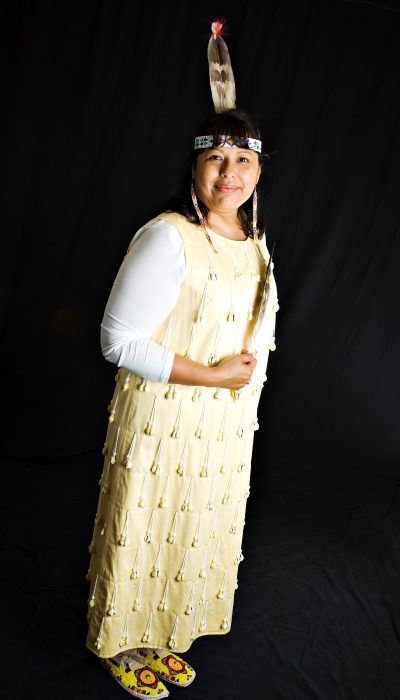
Neshi wearing traditional Medicine Dress
On Standing Rock
Standing Rock, literally it woke up the world. It shook the world. And so much came out of that both positive and negative. But really it brought the world together in that one tiny little space, they had over. 500. Indigenous flags flying. And people from all over the world came. Right. And the premise was to do this in peace and then the ceremony. And for the most part, that that was true. There are some things that occurred that you know.
The aftermath. But we all learned a whole lot from it. And. It really did ignite the passion and to for people to use their voice in their own backyards. Right. So, there’s a lot of things that have come out from this and the Sami came not once I think they were there like, three or four times different times over that.
It’s also a free press and they we’re really riding on the edge of an extinction of the free press. Really. We’ve been dealing with the US government for generations and we’ve survived we’ve survived them time and time and time again. Now that doesn’t mean that we don’t have people like Leonard Peltier still in prison. It doesn’t mean that we don’t have a high proportion of numbers of Indigenous people in the prisons. But we’ve survived this government for a long, long time. A long time.
And so that that is why Standing Rock was so important because it was a renaissance that was reigniting, reclaiming our power as indigenous people.
Now many people would say that we don’t or that we don’t have much power. But Standing Rock really showed us that yes we do. And a very it turned out in a very quiet voice. And it was the youth that really brought it to the forefront and they turned to the elders that still knew the ceremonies that still knew how to call in spirit and have spirit present during that whole thing.
SOUND: Crickets.wav
Neshi On Spirit Guides
So many people non-native people non-Indigenous people to Turtle Island are still very, very interested in Native American or the indigenous culture. To be more specific in the spirituality. I encourage them to really search out who their people are.
But we’re carrying our ancestors’ wisdom and also their trauma in our DNA and our blood and in our bones. And so, we can make that connection through our ancestors. You don’t have to make that connection through my ancestry.
The culture I grew up in, we talked about spirit all the time, it wasn’t anything new, but coming into what’s been known as the new age world, realising that all these people had Native American guides. And I’m asking why don’t I have Native American guides? Because I don’t. So how come I don’t I have Chief Red Cloud as my spirit guide? And it’s like this because you call them ancestors. It’s like it’s like –oh OK so your light bulb went on.
But why do so many non-native people non-Indigenous people have Native American guides? Because they’re being taught or given opportunities to remember their connection to Grandmother Earth.
And so with indigenous people, our belief is really about our connection, that we have this very loving and strong connection to Grandmother Earth. Protecting sacred sites. Cleaning up the water. Picking up your own trash for goodness sake. Those kinds of things, right, is a calling on your spirit guides to help you to rekindle or reconnect to Grandmother Earth because it’s hard wired in us to like it’s in us humans. To protect what we love. And if we can remember how much we love the Earth Mother Earth grandmother guy up we’re going to protect her.
Being indigenous to this continent and growing up the way that I did. OK. There’s some things that I took for granted. In my culture, that I didn’t realise until I was a young adult…. is that when you grow up in the culture, the spiritual connection that we have to the earth, it’s just your life, it’s your way of being.
You don’t question why we do ceremony. and call in the four directions, why we address Grandmother Earth and grandfather sky. because everything goes back to grandmother earth. Our culture is based on our connection to her. It’s your life, it’s your lifestyle already.
There’s many of us who do keep that connection and nurture it because like any other relationship you’d have to pay attention to it. And so sometimes they think that we take for granted that kind of connection. It’s when someone else outs that’s not indigenous, they’re looking in to this life, they see this connection and they yearn for belonging.
And so I think that’s where you get a lot of people wanting to have the same kind of connection but really. Really trying their best to be able to do that. And sometimes it takes on a different a whole different role.
In order to have to retain and to foster to nurture that relationship to Grandmother Earth you have to practice it every day that becomes your lifestyle. That is your life. And so it’s a way of being and it’s a way of walking this earth is to be able to remember your connection to her and it becomes your lifestyle you live it every single day.
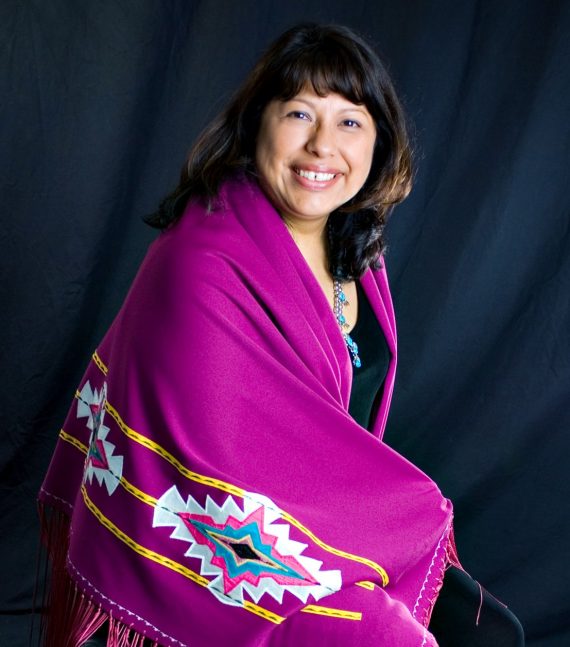
Yvette Neshi Lokotz
On cultural misapproproation
Cultural misappropriation basically, is a put a nice way of saying stealing. The using of another culture when it’s feeding your ego more than your soul then I think that you have to step back and say “What did I just steal?”
When you are an indigenous person and you’ve lived that life and you have people who are non-Indigenous coming into your home basically. you know your community, they feel like they can use it, without any of the training, without any explanation, without the foundational information. It’s for their ego more than it is for their soul.
And so that’s my two cents on cultural misappropriation is that many times it’s it’s being a part of themselves that is not a part of their spirituality. I think it is but it’s really feeding their ego. Those are the name droppers. They’re keen on the word Chief you know.
And I tell you there are some Native Americans some indigenous people who get very upset with this. They’re very upset because they you know I’ve heard it said that they’ve taken everything else and now they want to take our souls too. They want to take our Spirit.
On terminology and names
What do we call ourselves…. right. I agree it is important. Whether we call ourselves cells Native American or indigenous are First Nation is really for the benefit of the person that we’re speaking to that is non-native.
And it’s a misnomer. Let’s take the term Native American Native American really is what I would call a misnomer. OK. It has become antiquated because anybody who is born in the United States could could say that they’re Native American. So it kind of washes out the first people who were on this continent.
And so what, what do we ended up calling ourselves when we have multiple generations who have now resided in the United States. They came from a different continent. And so there is this term called colonisers and that we are being another thing being usurped from us. But. And. I in my world in actuality. The term Native American Doesn’t really describe the indigenous people here on Turtle Island, it really doesn’t describe, in truth the original people here. And especially not American Indian. (laughter) Because this this this man who said he found this new world we’re already here. And he was lost. He thought he was in the East Indies. That’s how we got the term Indian. That has nothing to do with the original people who were already here.
Now Canada has started a movement and calling natives from Canada Indigenous people from Canada started using the words indigenous. And also First Nation. Which I think is a bit closer to accurately describing people who were here originally on this. But you know what I tell you.
We slide back and forth between depending on who we’re talking to.
And I’ve also found that it’s generational.
Because my mother who just turned 100 on Saturday, she still uses the terms American Indian or Indian and also uses Native American. And no matter no matter how many times I will ask her, are referring to East Indian or indigenous people. And so, she’ll look give me this look and she says I’m referring to our people! (Laughter)
She was part of the mission school generation. And most non-indigenous people don’t realize that that’s still occurring that children are still being taken from their homes and placed in boarding schools to create a person who is more.
Non-native non-indigenous. Still happening in this century. Some things never change, I suppose.
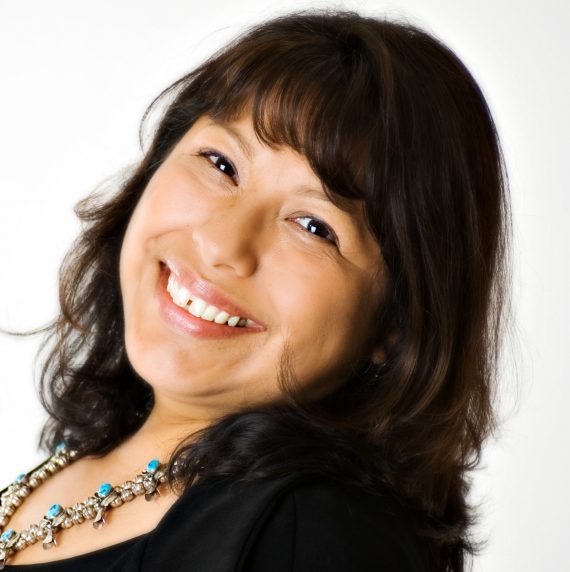
Yvette Neshi Lokotz
You know, I think language in itself falls short of really truly describing the emotions that are underlying, because even when we use the word ‘indigenous’ we have to qualify it indigenous to what continent. because there are many people who are Indigenous, but indigenous to their own part of grandmother earth right?
And so I think we still have to qualify what part of Grandmother Earth are we referring to when we’re talking about indigenous people.
Indigenous. It’s a start.
In the Indigenous world we there is a belief that our culture is connected to our language. And so, when you lose the language you lose your culture and so much has already been lost. And so there has been a many and about two decades worth of a renaissance where many people are learning their indigenous language.
On home
Our ancestors survived. Survive so that we could be here. They went through so much for us to be here to live these lives. They went through genocide. They went through colonization. They did what they had to do to survive, so that we could be here. It makes us stronger. For what they did for us now when we talk about where’s our home.
And the thing is is that we have to be clear in. When we use the term ancestor when I’m using it I’m talking about and referring to them as this spirituality the spirit of not the physical the spiritual. Not the physical place. No.
When we’re talking about our connection to the earth. We belong to her not the other way around. Literally our bodies come from her. And our bodies returned to her. When our spirit is released.
Our complete physicality. Is connected to her are brainwaves or connected to her.
She literally gives us Life.
On ceremony
Ceremony and ritual touches that part of our brain. We recognize it. Oh something important is happening here.
It’s about making that connection, to nature – or to all that is really. The creator, all the planets, the sun, the moon, the four directions, to all the animals, to all bodies of water, to all things green, to those who fly to those who swim to those who crawl, all of creation. The entire universe.
So when you do those kind of ceremonies, we are all watching and listening and we are also feeling our connection to each other and to the earth, and to all of creation and that we’re reminded that that we are a member, of nature. That we’re not separate from it or separate from each other.
And so when you’re looking at nature. And the ecosystem that we’re all a part of. It’s a very large body that we call Earth.
You can’t take one piece out and take a look at it and say this is this is the only thing that we’re going to be concerned about. There’s something from an indigenous point of view is that all of Grandmother Earth is sacred. All of it is not just one aspect over here one aspect over there but the whole. Is sacred. And that we have a commitment to her. To take care of her. That’s why we call her grandmother. (laughter) is that we have a commitment to take care of her.
And so if we can look at her as a whole being rather than bits and pieces of, that we can start to remember our connection to her. And that we actually see ourselves as a whole being rather than bits and pieces.
You know there’s another thing is that we don’t we don’t own her. If she decided that she was done with the human race done with a two legged it would be so easy for her to shake us off her body.
We have such a loving and complicated relationship with her. And she literally we are one of her children. So how does how does a parent how does a parent corrector. Explain to the child why they can’t do this you can’t do that or why they should do something.
How does a parent do that?
Shows them consequences. And I think we’re being shown consequences. And so, for those of us that are awake and we see sense or feel it is to be able to use our voices in some way. To say you know let’s listen to this. Let’s go out and actually pick up some trash. Take your children with you to pick up the trash. Yes. Yes. No, it doesn’t. You know some people think that it’s so overwhelming. What can I do? You know I’m not going to affect anything but when everything that we do affects someone else. We’re so interconnected.
Start locally, start in your own backyard. What are you doing to effect your own home. What are you doing? And so you know and if you feel like that’s the extent that you can help. Well then that’s fine that’s good at least you’re doing something. There’s others that will take on a more regional or national or international… Because they’re meant to.
How are we planting our garden, how are we tending it? We live in a world of duality. When you see. The really negative and the very low vibrational side of it. What’s the opposite? Because there is an opposite. So where is that? Where is that? And go there put your energy in there.
With gratitude
I can’t tell you how much I’ve appreciated this opportunity to be with you and to express, my belief my heart. We’re all a part of the same universe.
And so thank you. In Potawatomi It is Kttche Megwech, which is a very large thank you and Igwien, Igwien is a more formal thank you that we reserve for elders and for special occasions. And so I want to tell you Igwien.
END
CREDITS
TANYA’S VOICE:
SOUND: Tanya’s Garden in Sweden the Summer
Thank you for listening to this episode of Nordic By Nature, ON BELONGING. You can find more info on our guests and a transcript of this podcast on imaginarylife.net/podcast
Nordic by Nature is an ImaginaryLife production.
The music and sound has been designed by Diego Losa. You can find him on diegolosa.blogspot.com
Please help us by sharing a link to this episode with the hashtag #tracesofnorth and follow us on Instagram @nordicbynaturepodcast
We are also fundraising on panteon.com/nordicbynature.
If you are interested in nature-centred mindfulness please see foundnature.org to read about the Foundation for the Contemplation of Nature. You can follow the Foundation on Facebook, and on Contemplation of Nature on Instagram.
You can contact Andrew and Kayla Blanchflower via their website roguedwellings.com
Yvette Neshi Lokotz is the CEO of Star Nations, a multi-media company with a global community. Please see starnations.org.
We’d love to hear your thoughts on our podcast.
Please email me, Tanya, on nordicbynature@gmail.com
END

